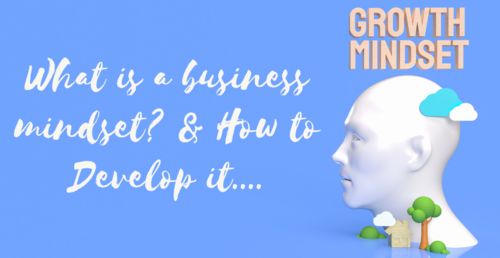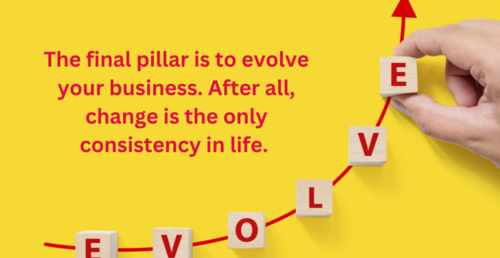
What is a Business Mindset? & How to Develop it....

A business mindset refers to an individual who constantly strives to act as a leader, manages the company they work for, and actively works towards making their own company a success. Examples of what this mentality entails would be an organizer or someone who is involved in the day-to-day management of their business. They think of their company as a living entity and work to improve it in every way they can.
This mindset focuses on creating value for the owner, employees, customers, and society as a whole. It also stresses that profits are not evil so long as they’re earned fairly. The business mindset encourages people to become entrepreneurs or better leaders in their current job instead of employees who just do their job.
A growth mindset is a way of thinking that focuses on personal growth and development. This mindset is helpful in business because if you focus on learning and improving, you will quickly become more successful. It also makes your success even more meaningful because it can help you develop a business that helps others too.
Your attitude will greatly affect how you interact with your customers and staff. This will impact the results of your business in many ways, especially if you have employees. Your attitude does not have to be one of defeat or discouragement, but rather one that is optimistic and one that focuses on growth.

When you have a business mindset, you will be open to learning new things and grow as a person. The more you learn and understand the value of everything, the more likely it is that your company will continue to succeed. You can also use this mindset to become a better leader and entrepreneur.
It can be difficult at first because people will look at you as if they are imposing on you with their ideas. But, you will always be the one who is responsible for making the company a success. The key is to focus on your goals and to keep learning new things so that your business can grow and expand.
In order to build the right small business infrastructure, you must think strategically — that’s having a business mindset. Here are seven examples of having a business mindset:
1. Having a business mindset is knowing that the purpose of business is to make money. Sometimes your hobby is just a hobby. Either you’re going to have a hobby that makes you a little extra money or you’re going to have a business that requires a higher level of development in order to acquire a higher level of income.
2. Having a business mindset means thinking for yourself vs. letting other people think for you. Don’t allow the experts to control your destiny or your dreams, let them help you get there. Take some time to think, document, research your own idea before asking for help — if you do — you will be better equipped to ask for exactly what you want and getting it.
3. Having a business mindset means being more strategic about your business activity. Don’t just go to any networking event or take on any job; know what results you want before you invest in business activity.
For example, do you know how much it really costs you to attend a training session or a networking event – Money, family, time, babysitter, gas, etc? In order to recoup your investment your reasons for investing in the training must be things other than meeting people and “I just want to learn something.” Why? That’s a given when you go to networking (meet people) or training (learn something). Your purpose for attending any event must be One, aligned with your vision and Two, focused on profitability. So make sure you have a specific outcome in mind before investing in business activities like networking and training.
4. Having a business mindset is knowing that we need to connect with our businesses and that connection is… profitability. How do you connect with your profitability? By knowing your profit margin, cash flow, competitive advantage, sales goals, and your key profit indicators.
5. Having a business mindset is understanding strategy and implementing it into your business practices. These days we tend to focus on the day-to-day mundane tasks and deadlines, solving short-term problems, and implementing marketing tactics that aren’t a good fit for our businesses. Strategy concerns itself with what’s ahead, looking at where you’re going and how to get there. Thereby, making you ask the question–“is this task in line with where the company is going and/or where I want it to go?”
6. Having a business mindset is being open to multiple streams of income and multiple businesses. I met a lady at a conference a while back, and I will never forget what she told me – “I have one business that’s my passion that makes me a good income and I run it. I have another business that generates substantial profit for me and I have someone else to run it.” The point: you don’t have to put all your eggs in one basket – that’s part of having a business mindset.
7. Having a business mindset is understanding your emotional ties to your business. Understanding the emotional ties to your business will allow you to break through your personal barriers that prevent you from doing what you say you’re going to do and also doing what you want to do. The next time you get emotional in your business jot down what you’re feeling and what triggered it, this is how you begin to recognize which emotions are keeping you from doing good business.
Main Takeaway: every business decision you make today affects your business today, tomorrow, and in the future – so become a good strategist. A good strategist looks at all facets of their business today in context of where they are trying to go. A good strategist reacts to problems positively instead of negatively. A good strategist also welcomes change and turns it into an opportunity. A good strategist can react quickly with the unexpected.

A good strategist has a business mindset.
Having a business mindset simply means you understand and appreciate the unique value you offer, and are able to implement and follow a strategy or action plan that ensures the recognition and financial success you deserve.
Creating value
First ask yourself first what it is that sets you apart from your competitors. What is the unique value you bring to the market? Try to summarize this in a few brief sentences so that it is clear and easy to market to your potential clients.
You can also think about the kinds of problems you are helping to solve and for which group, as well as who you are targeting specifically, and who else is doing something similar. Once you have identified your competitors, you should also think about how you can differentiate yourself from them. This will answer your client’s question “what unique value will you bring me if I choose you over your competitors?”.

Delivering value
You can have the best idea in the world, but it will not succeed if you do not know how to deliver it. Abraham reminds us that it is important to take a holistic approach by focusing on the pre, during, and post stages of delivering your product to create the best possible experience at every point.
So for example, pre-delivery could be looking at how you raise awareness of the product you’re selling, and how you enable them to make a purchase. Post-delivery can be how you are supporting your customers after they have bought your product, how you maintain a relationship with them, and how they can become part of your brand awareness strategy.
Capturing value
Creating and delivering value are obviously important, but they mean nothing if you’re not making a profit. Depending on which area you are working in, it can be easier or more difficult to decide on the price to set for your service. The most obvious way to do so is through market research and comparing your prices to your competitors, but there is another way.
Abraham introduces an approach called a “reverse engineering strategy”, which follows a very simple formula to work out your financial goals, yearly revenue, and how much to charge for your service or product based on those findings. Then, ask yourself where your money is coming from in order to clearly-define your income streams, before testing your target audience to see if they are willing to pay the rates that you have set.

Evolving
The final pillar is to evolve your business. After all, change is the only consistency in life. Evolving may be adapting your business, changing it completely, or innovating it. If you choose to evolve your business, first look at what it is exactly that you would like to focus on. Is it evolving your current offering? Or is it expanding your target audience?
Once you have decided, you need to research current activity in that area and look for inspiration. This will help you to generate ideas, and you can pick the most viable one to test a prototype and then evaluate whether it is worth implementing or not.
Using these four pillars as a reference is a good way to begin thinking and making decisions in a more business-oriented way, but you should be prepared to follow through with your action plan once you have designed it.
Now, why did I share this post with you? It’s so you can start thinking about learning how to develop a business mindset and apply it to your creative work for guaranteed success
(4).jpg)
Andries van Tonder
Serial Entrepreneur & Investor
Over 40 Years of experience in Business and Marketing.
Business is my passion and I have established myself in multiple industries with a focus on sustainable growth. You will generally find me online on Facebook, Twitter, WebTalk, Instagram & Markethive
